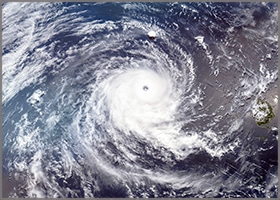
Hurray, we’re at the tail end of hurricane season! Now it’s time for chilly nor’easters, ice storms, blizzards, and winter cold spells!
It’s bad enough that we have to personally prepare for these events, but think about businesses. As far as individuals are concerned, a trip to the grocery store two days before the event may be enough. However, if a business only starts planning two days beforehand, they’re ripe for a disaster.
 The Changing Nature of Weather
The Changing Nature of Weather
All across the country, we’re seeing big differences in what were typical weather patterns. In 2018, we’ve had flooding throughout the South and Midwest. Record snowfalls predicted for a few days’ in Montana. Hurricanes again hitting the Carolinas. A heatwave in Alaska.
The weather is getting more and more unpredictable, and that holds true for the Northeast. A business can’t take weather for granted, thinking that strong weather-related events are an occasional anomaly. A business must be prepared for the worst at all times, because now, weather-related disasters are striking businesses on a regular basis.
To keep up with the changing times, here are a few tips to help businesses better prepare for weather-based disasters.
- Include Weather-based Events When Performing DR Risk Assessment
While not the leading cause of issues, weather could play a role in your next disaster. DR planners should look at weather history in their region, especially recent history, to find emerging trends. Based on findings, it’s a good idea to role-play scenarios that planners can most see affecting their business operations. The National Weather Service has a variety of tools and links to help businesses in their disaster recovery preparations.
- Don’t Forget About Floodwater
The Northeast isn’t impervious to floods, especially with hurricane and tropical storms continuing to move further north along the Atlantic coast. Check to see if any part of your business operations are in a flood plain, and if so, what the likelihood of flooding is. From there, determine the impact flooding will have based on the potential rise and inundation of water.
- StormReady Resources
StormReady is another program from the National Weather Service that helps communities, businesses, and local governments develop plans for every type of hazardous weather. Components of the plan include setting up an emergency operations center, weather monitoring systems, and holding emergency weather exercises.
- Determine How Long the Company Can Sustain Life Without Power
Keep in mind that with the global changes to weather patterns, downtime may last much longer than what a company expected the last time the DR plan was updated. Companies may want to look into generators and uninterruptible power supplies (UPSs) for critical networks and infrastructure. It’s also wise to consult with an electrician to get a thorough understanding of the company’s building wattage needs and what would be the most likely sources of a power outage.
- Analyze Backup Systems
What’s in place to back up the company’s servers, systems, and databases? Does the company have a cloud partner, or are they using DRaaS? A data backup plan should include a mix of solutions that can keep major operations running and protect the loss of data in the event of a weather emergency.
- Can Employees Work Remotely?
With cloud computing, the ability for employees to work remotely is now the norm. Look into a secure cloud network that can keep employees plugged in and working from wherever they may be. As long as they have power, the majority of employees should still be able to carry out their job functions regardless of weather conditions at the main office. This is especially important for consumer-facing personnel.
- Add an Emergency Notification System
Make sure it’s available to all employees, both for their personal safety and the health of the business. If an emergency strikes, use this system to send out tips for preparation. Also, establish a backup call tree for alerting employees manually. No employee should be left in the dark, even if the HQ is literally in the dark.
 Ready to Examine or Set Up Your DR Plan
Ready to Examine or Set Up Your DR Plan
While the Northeast may be bracing for another snowy winter, believe it or not, weather related disasters are not the top cause of downtime; ransomware, power loss, accidental deletion, software failure, hardware failure—they can happen any time of year and without warning. Comprehensive disaster recovery planning should be top of mind all year long and you have a solid partner in FirstLight. We have the experts on hand to help you design a strategy to keep your critical data and applications accessible during any downtime event. Cloud-based disaster recovery (DRaaS) is affordable, easy to implement and a good first step in crafting an overall plan to protect your company from whatever mother nature may throw at us.
Contact us today to get started before the next weather-related event!




















